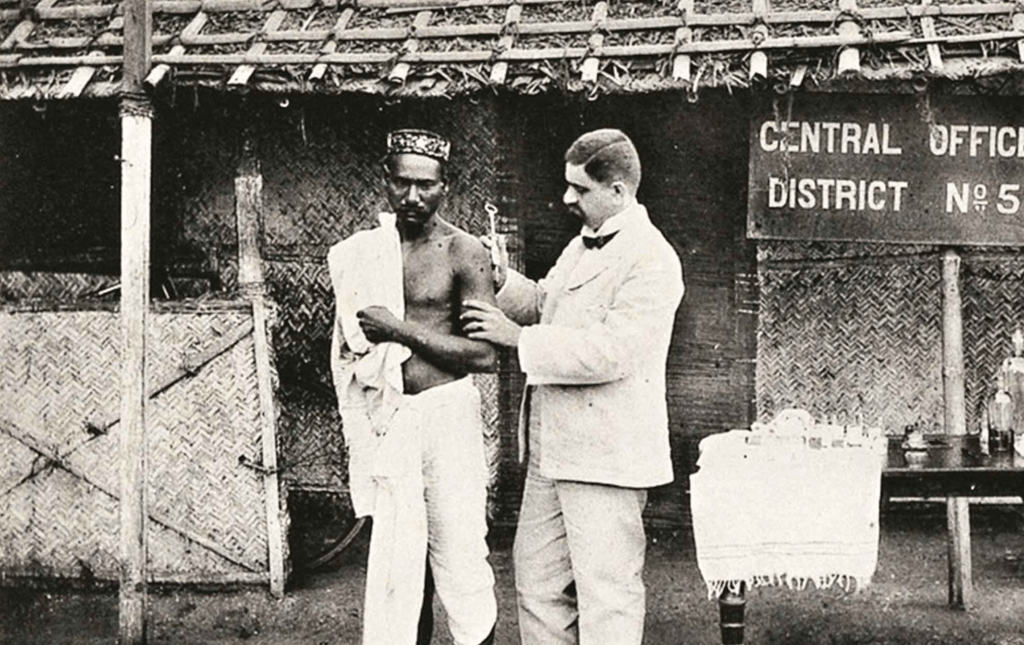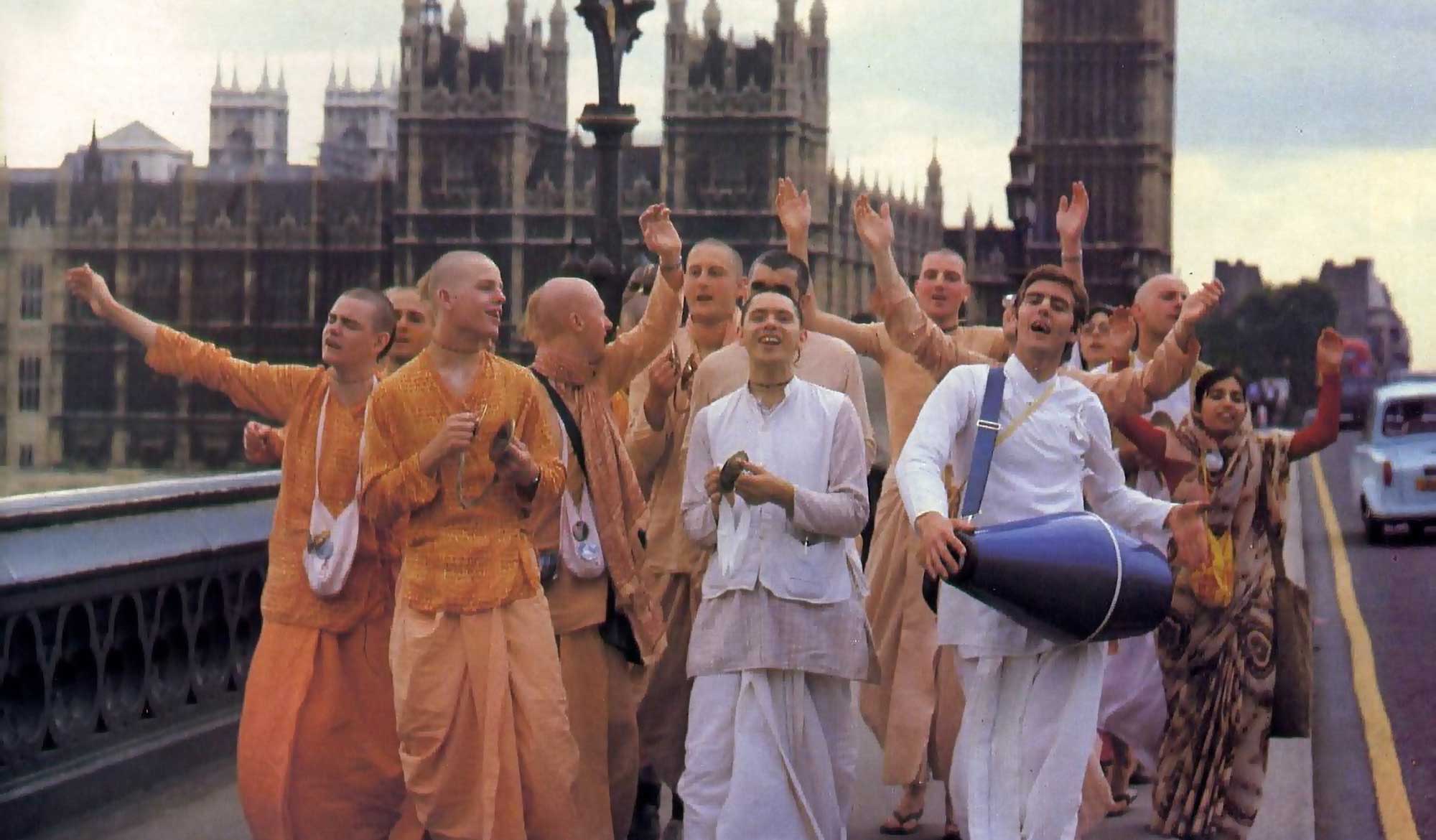Overview
Bhek Dhāraṇa (Accepting the Dress of a Bābājī) was first published in Sajjana Toṣaṇī Vol. 2 issue 7 in 1885. In this article, Bhaktivinoda Ṭhākura discusses bhek-dhāraṇa (the acceptance of the bābājī āśrama) and how those who have polluted it are ‘a black spot on Vaiṣṇava dharma.’
(translated by Swami B.V. Giri)
Some mahātmā Vaiṣṇava has asked us some questions about this topic. I won’t list those questions here as I am only inclined to give the answers.
Bhikṣu or Bhek Āśrama
The word bhek refers to the bhikṣu āśrama. According to śāstra and logical opinions, there are only four āśramas for mankind – gṛhastha-āśrama, brahmacārī-āśrama, vānaprastha-āśrama and sannyāsa-āśrama. Look at it through the eyes of science, or look at it through the eyes of scripture – apart from these four āśramas, no other āśrama is possible for the human race. You can’t even reduce the number of āśramas. A deliberation on the principle of all these āśramas will be fully examined in the book, Śrī Śrī Caitanya Śikṣāmṛta. At this time, I will explain it in brief for convenience sake.
Those who are socially bound by marriage remain in the gṛhastha-āśrama. Those persons who leave their wife and travel alone are members of the sannyāsa-āśrama. Between them is the brahmacārī and the vānaprastha. A brahmacārī can become a gṛhastha by taking a wife, or directly take sannyāsa. One who is in the vānaprastha-āśrama can associate with his wife in some places. The name of the sannyāsa-āśrama is bhikṣu āśrama. A sannyāsī can no longer associate with his wife in this life. He will maintain his life by bhikṣā (begging).
Now the question is, which āśrama are the Vaiṣṇavas who accept bhek located in. By deliberating upon the śāstra and the teachings of Śrīman Mahāprabhu, we have come to the conclusion that such solitary Vaiṣṇavas have accepted the bhikṣu āśrama. When association with women is completely forbidden for them, their āśrama is known as sannyāsa. The symbol of sannyāsa is the kaupīna. They accept this. Thus they are situated in the bhikṣu–āśrama and they cultivate Vaiṣṇava dharma. Here it is to be considered whether it is proper, according to śāstra and proper reasoning, for persons from all varṇas to accept Vaiṣnava bhek, since they have accepted the fourth āśrama. Our conclusion is that according to the śāstra, no one is entitled to accept sannyāsa-āśrama except for those within the brāhmaṇa varṇa. The statements of the śāstra are always pure. Within the perfect Veda śāstra, there is no bhrama (mistakes), pramāda (illusion) etc. It is futile for a man to take sannyāsa if he does not possess the characteristics of the brāhmaṇa-varṇa that are mentioned in the śāstra. For example, if there are no qualities such as śama (control of the internal senses) dama (control of the external senses) etc., then a man entering the sannyāsa–āśrama will soon become a disgrace to that sacred āśrama due to his desire for lasciviousness and enjoyment. Therefore, no one has the qualification to enter the sannyāsa-āśrama except for a brāhmaṇa. In the age of Kali, the practice of determining varṇa according to one’s nature has completely stopped. Now brāhmaṇism is only by birth. It is rare to find someone qualified in the sannyāsa-āśrama from the brāhmaṇa community here. By deliberating upon esoteric śāstra, Śrī Śrī Mahāprabhu gave permission for mahājanas such as Śrī Raghunātha Dāsa etc. to accept the bhikṣu āśrama. The paddhati (text explaining this method) for accepting bhek has been in vogue since that time. There is no fault with this śāstra or method. There is no fault with those who first introduced this paddhati. There are only faults according to the time. There is no doubt that sannyāsa is as abominable to a person who has attained the status of a brāhmaṇa, as the acceptance of bhek is to unqualified men of other varṇas. Everyone can attain the qualification to accept this āśrama. But until they attain that qualification, everyone should remain engaged in the duties of a gṛhastha.
It is incumbent upon us to consider the emergence of those qualifications for accepting bhek. Humans alone have the right to become gṛhasthas. A gṛhastha can accept a wife, but there are physical and mental health requirements that are necessary for accepting a wife. Even without a wife, disabled people can become gṛhasthas with the help of other gṛhasthas. What we are saying is that there are a few conditions that must arise before accepting bhek or taking sannyāsa.
Qualities of a real Renunciant
1) Śama, dama, titikṣā and vairāgya – when these four inherent qualities appear, one is qualified for the bhikṣu–āśrama. Titikṣā (being able to tolerate misery etc.) and vairāgya (understanding everything in terms of material objects and transcendental objects) are the two most important qualities of a sannyāsī.
2) It is necessary to distinguish between material objects and transcendental objects.
3) Desiring transcendental objects is the superior approach.
A body in which these three attributes appear in is entitled to receive the paraphernalia of sannyāsa.
Generally, there is a slight difference in sannyāsa-dharma and Vaiṣṇava sannyāsa. All that is necessary for general vārṇika-sannyāsīs (sannyāsīs belong to the higher varṇas) is śama, dama, titikṣā, vairāgya and knowledge in relation to sat (spirit) and asat (matter), in order to attain Brahman. If Vaiṣṇava sannyāsīs only have these qualities, they are not qualified for bhek. Firstly, they have to possess the characteristics of a devotee such as śraddhā, then sādhu–saṅga, then bhajana and anartha–nivṛtti etc. When attraction for Bhagavān arises through this process, then naturally, renunciation takes refuge in that Vaiṣṇava. When that takes place, a Vaiṣṇava no longer likes the gṛhastha-āśrama which is entirely based upon useless activities. Then Vaiṣnavas, in order to alleviate their necessities, wear a kaupīna etc and maintain their lives by begging. This is known as Vaiṣṇava bhek. One who accepts bhek with simplicity is revered by the whole world. There are two methods of accepting bhek. Some people accept bhek from a sādhu when a feeling of renunciation arises in them. Others accept it by embracing the symbols of renunciation themselves and travel around. Śrī Śrī Mahāprabhu’s method of bhek is very pure. With our heads, we faithfully and continually offer our daṇḍavats to that process.
Contamination of the Bhek-āśrama
However, it is an unfortunate thing that the bhek–āśrama, like the sannyāsa-āśrama of the brāhmaṇas, has become very contaminated nowadays. Any consideration of qualification has totally gone. At a moment’s notice, those who desire to accept bhek shave their heads and accept a kaupīna. Today, in Vaiṣṇava society, some of the following atrocities have become prevalent in regards to bhek. Far from approving of these misdeeds, all the simple-hearted Vaiṣṇavas and sādhus, who are the recipients of Śrī Śrī Mahāprabhu’s mercy, cover their eyes with their hands.
1) Many gṛhastha Vaiṣṇavas shave their heads, wear kaupīna, and become bābājīs while remaining in their own homes. What is the problem in waiting? What is the necessity of mixing up the āśramas? If renunciation is there, then the proper situation is to accept bhek and remain alone. If renunciation is not there, then what is the benefit of accepting the paraphernalia? Vaiṣṇava dharma is simply being tarnished by such people. Naturally, they will suffer the consequences in the afterlife.
2) It is an evil and inauspicious practice for those bābājīs who reside in an ākhaḍa (an āśrama for bābājīs) to keep female servants there. In some ākhaḍas, the former wife of a bābājī lives there as a servant. In those ākhaḍas where there are no women walking around, there are no men who are actually renounced. The basic principle of all these activities is that they use deva-pūjā and sādhu–sevā as a deception for associating with women.
3) The desire for women, wealth, food and mundane pleasures should be completely avoided by reclusive bābājīs. The entire Vaiṣnava world becomes distrustful of all those men who live alone, accepting the symbols of a renunciate while engaging in all sorts of nefarious activities. The point is that attraction for Bhagavān is not generated by renunciation, and one who simply bears the signs of renunciation is certainly a nuisance to the world and a black spot on Vaiṣṇava dharma.
Qualifications for Accepting Bhek in Vaiṣṇava Dharma
Indeed, indiscretion and ill-motives are the mother of all these evils. Everyone should examine their qualifications with special care before accepting bhek. It is not necessary to accept bhek. If bhek is accepted according to the proper rules, then all perfection will come from that. Following the rules unnecessarily and taking bhek degrades the self and is an offence to Vaiṣṇava dharma. We make this kind of appeal to the world with folded hands.
O honourable men! Act by considering your qualifications. Eligibility is the root of all things. Bhagavān has said:
sve sve’dhikāre yā niṣṭhā sa guṇaḥ parikīrtitaḥ
viparyayas tu doṣasyād-ubhayor eṣa nirṇayaḥ
(Bhāgavatam 11.21.2)
Steadiness according to one’s own qualifications is a good quality. The opposite is known as a fault. Therefore do not act without considering one’s eligibility. While renunciation has not manifest, continue to maintain one’s household duties and cultivate kṛṣṇa-bhakti. If renunciation has manifest, leave home and travel. In the Eleventh Canto, Bhagavān states:
jāta-śraddho mat-kathāsu nirviṇṇaḥ sarva-karmasu
veda duḥkhātmakān kāmān parityāge’py anīśvaraḥ
(Bhāgavatam 11.20.27)
“As long as one is unable to leave the home, one should nurture śraddhā and renounce the results of all actions. One should know that all material desires are full of suffering, and one should condemn their ultimate results as evil. In this way you should have śraddhā in Me and engage in My bhajana with love.”
O sādhus! These are the characteristics of a gṛhastha Vaiṣṇava. Kaṭiṁ kṛtvā vanaṁ vrajet. It is clear from this Vaiṣṇava tantra that accepting bhek and remaining in one’s home is not a characteristic of a Vaiṣṇava. Just see Bhagavān’s teachings concerning the attributes of accepting bhek and travelling around:
ājñāyaivaṁ guṇān doṣān mayādiṣṭān api svakān
(Śrīmad Bhāgavatam 11.11.31)
And later:
sa-liṅgān āśramāṁs tyaktvā cared avidhi-gocaraḥ
(Śrīmad Bhāgavatam 11.18.28)
“One should see both the good qualities and faults within varṇāśrama–dharma, then abandon these and perform bhajana to Me. Then giving up all the paraphernalia connected with that āśrama and transcending all the rules, one should enter the pāramahaṁsya Vaiṣṇava āśrama and travel around.”
From this statement one should not think of the Vaiṣṇava āśrama as a fifth āśrama. Whatever āśrama you stay in, you should give up material attraction, fully abandon the paraphernalia of that āśrama and with enthusiasm for kṛṣṇa-bhakti, adopt the conduct of devotees. I will not say anything more about this topic for the time being. There will be more discussion on this subject later as necessary. If Vaiṣṇava dharma is to be rescued from the mud, all efforts must be made to eradicate such misconduct.
During that time, whatever the infinitely merciful Śrī Śacīnandana will make us say, we will only say that. Offering full daṇḍavats to the feet of the Vaiṣṇavas, I will stop for today.













